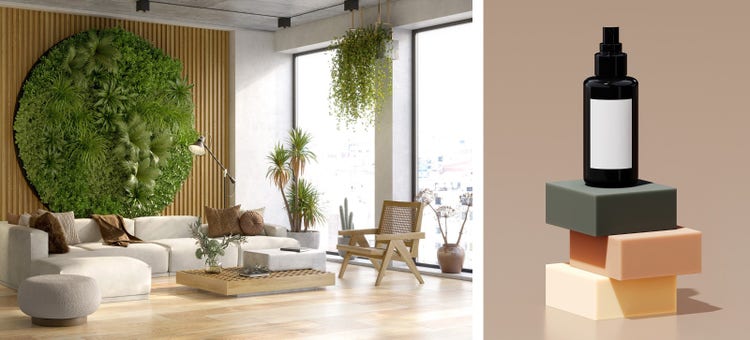New Naturalism design marries simple surfaces with big forest vibes

When the situation calls for aesthetics that are grounded, welcoming, and organic, Adobe Stock Design Trend New Naturalism is a fit, with on-trend energy and deep roots.
Clean, modern forms take on a warmer feel when rendered in earthy materials like wood and raw ceramic, and neutral, natural tones make for understated-but-engaging palettes. Forest-foraged, dug from the clay, and deceptively simple, New Naturalism celebrates the genius of welcoming organic energy into the home and studio.
Rooted in cultural movements that sought to reconnect with nature, this design trend is a clear choice for lifestyle brands and imagery that seeks to imbue balance, calm, and peace – but it also offers modernist sophistication for dialed-down interiors that have simple surfaces and big vibes.
Hippie Modernism and the pursuit of utopia
Back-to-the-earth movements have a long cultural history, enjoying a special Renaissance in the 1960s and 1970s. During that period of social unrest, many radical movements were born with the intention of dismantling societal and professional structures, challenging traditional morays and hierarchies, engaging new media and materials, and forming communities that sought collective solutions to daily living.
In addition to producing some of the most iconic art, political activism, and music of the last 100 years, many artists, architects, and designers set out in pursuit of utopia. Though this ideal is, by definition, unattainable (utopia literally translates as “no place”), the results were utterly unique, astonishing, and beautiful, and continue to be revisited as highlights of experimental aesthetics.
Hippie Modernism: The Struggle for Utopia features furniture, alternative living structures, immersive and participatory media environments, alternative publishing and ephemera, and experimental film from the era. The exhibition showcases many of the ground-breaking aesthetics of the time, including examples of functional design, conceptual art, information design, bio-sphere construction, and independent publishing. Now, 50 years after the inception of many of these ideas, they provide a touchstone for producing materials within the New Naturalism trend, that feel all-too-relevant as society once again experiences a great restructuring of systems, values, and ideals.

Found palettes from the forest floor
For colorways, one need look no further than a walk through the woods. Everything in New Naturalism suggests an origin in nature, so this is not the trend for neon enthusiasts. Warm ranges offer blushes of pink, desert oranges, and a complete range of wood-tone browns; cool colors draw from the forest canopy and floor, with evergreens, sage, slate greys, dark-water blues, and perhaps the occasional pop of mossy green.
Materials are simple, but emphasize the incredible variety found in nature, such as variegated stone or marble, wood grains, and chalky, matte finishes. Paper pulp, woven baskets, and thick, natural fibers offer textural counterpoints to clean, open surfaces and soft, organic curves. Low furniture and modernist takes on geodesic domes and other forms of temporary construction employ wood, canvas, and glass for an open feeling. These aesthetics tie modern New Age interests to idealistic science fiction, including sound baths, infrared saunas, and other advances in holistic health and reflective contemplation. Font treatments are clean, uncluttered, free of flourishes, visually reinforcing a sense of conveying truth and simplicity. From an illustration standpoint, New Naturalism includes clean, graphic, black-and-white composition that can employ text and abstract line work.
Much like a Zen rock garden, New Naturalism aesthetics seem straightforward and uncomplicated, but require a strong editorial eye to maintain a sense of cohesion and balance.

Visuals that balance structure and the organic
New Naturalism visuals are inspired by process art, post-minimalism, and clean living, being leveraged most notably in fashion, beauty, and interior design. The work of Midcentury Modern vanguard Alexander Girard shows that modernism can be organic and playful, not just clinical and hermetic; New Naturalism seeks to imbue the clean refinement of modernism with the infinite open possibilities of nature.
Composition is key in this trend, which creates tension and interest through the balance and juxtaposition of simple elements. Just as movements within architecture sought to create structures that work in tandem with their surroundings, New Naturalism aesthetics seek to generate harmonious outcomes between structured and organic elements.
Horticulturalist and plantsman Kelly D. Norris’s book “New Naturalism” presents visions for home gardening that draw from a lineage of perennial planting popularized by Dutch designer Piet Oudolf – whose international projects famously blend modern architecture with thriving flora. In fashion, New Naturalism will eschew heavy makeup and over-styling in favor of cleaner, earthier looks and materials, and a higher frequency of adopting ecological and retro styles. This trend is a natural pairing with products touting sustainability, with new fashion materials are constantly being developed, including mushroom leather and sugarcane sneakers.
Ultimately, New Naturalism is as adaptable and fluid as the environments from which it draws inspiration. It’s a great trend to hone skills as a stylist and composer of impactful imagery using simple elements. By using just what’s at hand, practitioners of New Naturalism can revel in the beauty of everyday objects, materials, and surroundings, and add their vision to a tradition of accessible and sustainable materials.
New Naturalism in stock imagery and design
New Naturalism is a strong and growing trend we’re seeing in brand visuals and campaigns across industries — and that means lots of opportunities for high quality stock visuals. Get inspired with the New Naturalism Call for Content here on the Artist Hub. Then upload your latest vector designs and illustrations to Adobe Stock.

Stay informed
Get exclusive stock artist tips.
Sign up for our Adobe Stock artist newsletter to get the latest creative trends, stock industry insights, curated inspiration galleries, calls for content, and more.
/stock/en/artisthub/footer.html
